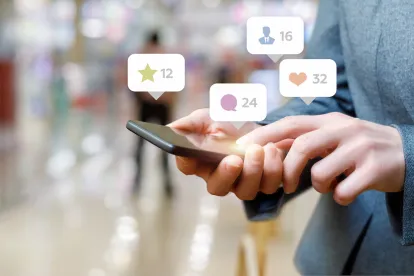Business lawyers and other trusted advisors need to pay attention to where other people’s attention is wandering. That’s where the money rests, and you must learn how it works to properly advise clients in their online strategies.
I grew up in a factory town. Most of the residents at that time earned money by making or selling car parts, refrigerators, business machines and paper products. My mother felt that there could be no economy unless you were producing tangible goods.
The entire nature of our earning capacity has changed in my adult lifetime. Physical factory jobs are now more often performed by robots and the college-educated engineers who fix them than what we used to call blue collar workers. Instead, countless people now earn a living attracting our attention on screens.
University College London professor David Evans estimated the attention economy in 2016 to include 437 billion hours, worth $7.1 trillion dollars. As we sit isolated in our homes, it just keeps growing.
Some of these attention workers still remain in what anyone over 35 might recognize as traditional content creation jobs – radio, television and movie production, publishing and journalism, and the advertising that supports them. But many of the new attention earners are being paid for activities that my mother wouldn’t even recognize, like e-sport celebrities, Tik Tok content producers, podcasters and social media influencers.
An influencer is a person that other people – people who have never actually met the influencer – respect and look to for guidance. In some sense our society has had influencers for ages, since Mark Twain’s Innocents Abroad promoted a surge in travel to the Europe and the Middle East and since Hollywood actors were tapped to sell soap and clothing.
Word of mouth marketing – encouraging influential people to talk about the brand spontaneously and virally has long been a powerful advertiser asset. Social media takes that to a whole new level and empowers both the brand and its influencers with a new kind of bull horn. Social media, with its emphasis on sharing, liking, following, and tagging, has made it so much easier for anyone to publish thoughts or actions and directly catch the attention of thousands, hundreds of thousands, even millions of people without ever leaving home or appearing in a movie or sports arena. And people who have gathered a herd of social media followers (influencers) are learning how to milk it. Though numbers of followers aren’t everything. There are also successful micro-influencers who have the capacity to engage meaningfully with niche audiences.
An NPR story reports that brands are going to spend more than $10 billion on influencer marketing in 2020. One of the most attractive aspects of internet marketing to advertisers is the one-to-one statistical connections that can attach to ads, unlike earlier mass media like radio and pre-digital television. With digital influencers, subscribers, followers and ‘likes’ are the coin of this realm, but these numbers are easier to fake than we used to believe, and advertisers are investing in software to help measure and manage media campaigns. Clickfarms can sell 1,000 social media followers for $49 (YouTube), $34 (Facebook), $16 (Instagram).
The amount of money generated by Instagram influencers alone is expected to reach $2.3 billion this year. The same study showed that 89% of marketers said in 2019 that Instagram is strategically important to their influencer marketing strategy, and that high-end influencers can earn enough from a single Instagram post to feed thousands of families for a year — celebrities like Selena Gomez earn roughly $800,000 per sponsored post, while Kylie Jenner pulls around $1 million per sponsored Instagram post.
Instagram, with more than a billion users, has added features to support this spending, including “Instagram Stories” which can be a video or series of photos joined with text or emojis, and now can include links to a sponsor’s advertising campaign. According to Vogue Business, Instagram has added creator accounts for high profile influencers and has culled the less authentic ‘likes’ on posts, believing that more accurate counts will push higher sales.
But not everyone can expect truckloads of cash to monetize a high follower count. Atlantic writer Taylor Lorenze said in the NPR story cited above, “most of these people don’t even have formal contracts. That’s the first problem. I mean, brand deals are negotiated over direct messages on different platforms. It’s very fluid and very casual. You know, if you’re the top 1% of YouTubers or Instagram stars, you’re likely to have management or maybe you’re repped by a talent agency. But for the vast majority of so-called influencers, they’re doing it all themselves.” And some of the middlemen, like Speakr, representing influencers, simply refuse to pay them after endorsements are made.
Like many musicians and baseball players in the middle of the last century, people interested in making money from digital platforms can sign contracts with agents, producers or other middlemen that strip them of the true value arising from their productivity. The business people can take advantage of soon-to-be celebrities by locking in contracts without allowing for increases in popularity and the financial benefits it brings.
The New York Times published a story last week about two young podcasters that became so popular that their shows were worth $100,000 per episode to their production company. That company “offered the hosts a guaranteed base salary of $500,000 a year, plus bonuses, among other incentives that he estimated would ultimately net them millions.” The podcast, named Call Her Daddy, was a raunchy view into the sex lives and opinions of the two hosts, twenty-something New York women, whose rocket to popularity made them stars and gave them over a million followers each on Instagram. As we have seen, this kind of celebrity brings serious “influencer” sponsorship money, as well as the ability to expand their brands into lucrative new arenas. The two podcast hosts have split over whether staying with this production company is worth the work (the work, of course, entails only talking about sex to your friend once a week), as one wants to take the deal offered and the other may prefer to strike out on her own now that she is a celebrity.
The Times article quotes podcaster Grace Atwood saying, “These girls have nearly one million followers, they can make $10,000 or $20,000 for a single Instagram post,” she said. “You can take that audience and do anything. You could start a fashion label, you could start a spinoff podcast. If that audience likes and trusts you, there’s literally endless things you can do with it.” The above-mentioned Kylie Jenner took her multiple platforms and started a billion dollar cosmetics line, becoming one of the world’s few self-made female billionaires.
So let’s recap. New media creates celebrities. In today’s world (and in part, thanks to new media) it is easier than ever to turn celebrity into income. But getting noticed is difficult as is protecting yourself from the companies that help you be noticed. As the New York Times wrote, “The systems for monetization are also increasingly complex. Most aspiring podcasters don’t think of negotiating things like ownership of their back catalog, licensing agreements, platform exclusivity, intellectual property and more, upfront.”
With attention difracted in a million different directions, people can develop an apparently small niche into a large herd of online followers, opening to influence-based advertising money. Lawyers and business advisers need to be aware not only of how the economy is changing, but of the complicated business models that allow both influencers and their production companies to capitalize on their moment in the sun. Competent business and financial advice is critical, but advisers need to keep up with the flows of money in the new economy. There are also more traditional legal issues to navigate like exercising care with product claims made by influencers on behalf of advertisers, avoiding IP infringement in influencer-generated content, and complying with FTC endorsement requirements.
Paying attention to the attention economy can pay off.




 />i
/>i
